Jiaxi Yang
additional authors not shown
SWE-Flow: Synthesizing Software Engineering Data in a Test-Driven Manner
Jun 11, 2025Abstract:We introduce **SWE-Flow**, a novel data synthesis framework grounded in Test-Driven Development (TDD). Unlike existing software engineering data that rely on human-submitted issues, **SWE-Flow** automatically infers incremental development steps directly from unit tests, which inherently encapsulate high-level requirements. The core of **SWE-Flow** is the construction of a Runtime Dependency Graph (RDG), which precisely captures function interactions, enabling the generation of a structured, step-by-step *development schedule*. At each step, **SWE-Flow** produces a partial codebase, the corresponding unit tests, and the necessary code modifications, resulting in fully verifiable TDD tasks. With this approach, we generated 16,061 training instances and 2,020 test instances from real-world GitHub projects, creating the **SWE-Flow-Eval** benchmark. Our experiments show that fine-tuning open model on this dataset significantly improves performance in TDD-based coding. To facilitate further research, we release all code, datasets, models, and Docker images at [Github](https://github.com/Hambaobao/SWE-Flow).
Topological Structure Learning Should Be A Research Priority for LLM-Based Multi-Agent Systems
May 29, 2025Abstract:Large Language Model-based Multi-Agent Systems (MASs) have emerged as a powerful paradigm for tackling complex tasks through collaborative intelligence. Nevertheless, the question of how agents should be structurally organized for optimal cooperation remains largely unexplored. In this position paper, we aim to gently redirect the focus of the MAS research community toward this critical dimension: develop topology-aware MASs for specific tasks. Specifically, the system consists of three core components - agents, communication links, and communication patterns - that collectively shape its coordination performance and efficiency. To this end, we introduce a systematic, three-stage framework: agent selection, structure profiling, and topology synthesis. Each stage would trigger new research opportunities in areas such as language models, reinforcement learning, graph learning, and generative modeling; together, they could unleash the full potential of MASs in complicated real-world applications. Then, we discuss the potential challenges and opportunities in the evaluation of multiple systems. We hope our perspective and framework can offer critical new insights in the era of agentic AI.
Tianyi: A Traditional Chinese Medicine all-rounder language model and its Real-World Clinical Practice
May 19, 2025Abstract:Natural medicines, particularly Traditional Chinese Medicine (TCM), are gaining global recognition for their therapeutic potential in addressing human symptoms and diseases. TCM, with its systematic theories and extensive practical experience, provides abundant resources for healthcare. However, the effective application of TCM requires precise syndrome diagnosis, determination of treatment principles, and prescription formulation, which demand decades of clinical expertise. Despite advancements in TCM-based decision systems, machine learning, and deep learning research, limitations in data and single-objective constraints hinder their practical application. In recent years, large language models (LLMs) have demonstrated potential in complex tasks, but lack specialization in TCM and face significant challenges, such as too big model scale to deploy and issues with hallucination. To address these challenges, we introduce Tianyi with 7.6-billion-parameter LLM, a model scale proper and specifically designed for TCM, pre-trained and fine-tuned on diverse TCM corpora, including classical texts, expert treatises, clinical records, and knowledge graphs. Tianyi is designed to assimilate interconnected and systematic TCM knowledge through a progressive learning manner. Additionally, we establish TCMEval, a comprehensive evaluation benchmark, to assess LLMs in TCM examinations, clinical tasks, domain-specific question-answering, and real-world trials. The extensive evaluations demonstrate the significant potential of Tianyi as an AI assistant in TCM clinical practice and research, bridging the gap between TCM knowledge and practical application.
Unlearning for Federated Online Learning to Rank: A Reproducibility Study
May 19, 2025Abstract:This paper reports on findings from a comparative study on the effectiveness and efficiency of federated unlearning strategies within Federated Online Learning to Rank (FOLTR), with specific attention to systematically analysing the unlearning capabilities of methods in a verifiable manner. Federated approaches to ranking of search results have recently garnered attention to address users privacy concerns. In FOLTR, privacy is safeguarded by collaboratively training ranking models across decentralized data sources, preserving individual user data while optimizing search results based on implicit feedback, such as clicks. Recent legislation introduced across numerous countries is establishing the so called "the right to be forgotten", according to which services based on machine learning models like those in FOLTR should provide capabilities that allow users to remove their own data from those used to train models. This has sparked the development of unlearning methods, along with evaluation practices to measure whether unlearning of a user data successfully occurred. Current evaluation practices are however often controversial, necessitating the use of multiple metrics for a more comprehensive assessment -- but previous proposals of unlearning methods only used single evaluation metrics. This paper addresses this limitation: our study rigorously assesses the effectiveness of unlearning strategies in managing both under-unlearning and over-unlearning scenarios using adapted, and newly proposed evaluation metrics. Thanks to our detailed analysis, we uncover the strengths and limitations of five unlearning strategies, offering valuable insights into optimizing federated unlearning to balance data privacy and system performance within FOLTR. We publicly release our code and complete results at https://github.com/Iris1026/Unlearning-for-FOLTR.git.
Parallel Scaling Law for Language Models
May 15, 2025Abstract:It is commonly believed that scaling language models should commit a significant space or time cost, by increasing the parameters (parameter scaling) or output tokens (inference-time scaling). We introduce the third and more inference-efficient scaling paradigm: increasing the model's parallel computation during both training and inference time. We apply $P$ diverse and learnable transformations to the input, execute forward passes of the model in parallel, and dynamically aggregate the $P$ outputs. This method, namely parallel scaling (ParScale), scales parallel computation by reusing existing parameters and can be applied to any model structure, optimization procedure, data, or task. We theoretically propose a new scaling law and validate it through large-scale pre-training, which shows that a model with $P$ parallel streams is similar to scaling the parameters by $O(\log P)$ while showing superior inference efficiency. For example, ParScale can use up to 22$\times$ less memory increase and 6$\times$ less latency increase compared to parameter scaling that achieves the same performance improvement. It can also recycle an off-the-shelf pre-trained model into a parallelly scaled one by post-training on a small amount of tokens, further reducing the training budget. The new scaling law we discovered potentially facilitates the deployment of more powerful models in low-resource scenarios, and provides an alternative perspective for the role of computation in machine learning.
Qwen3 Technical Report
May 14, 2025
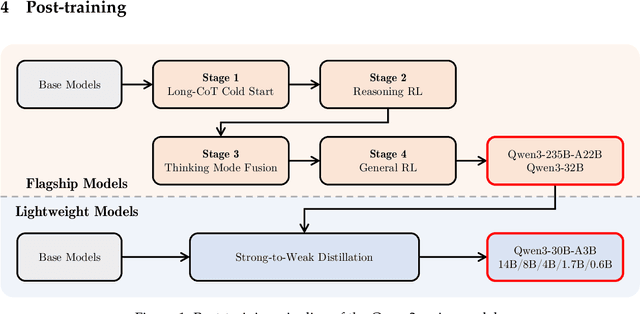

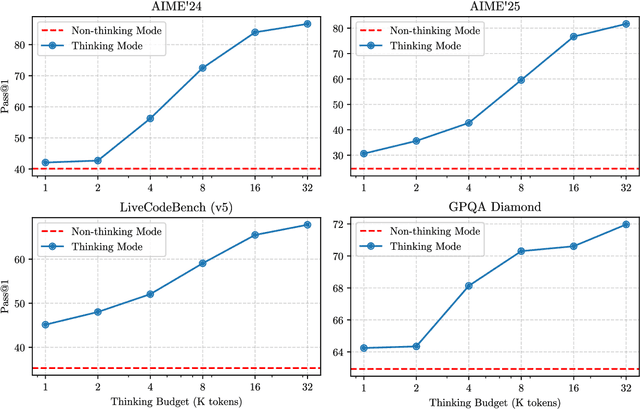
Abstract:In this work, we present Qwen3, the latest version of the Qwen model family. Qwen3 comprises a series of large language models (LLMs) designed to advance performance, efficiency, and multilingual capabilities. The Qwen3 series includes models of both dense and Mixture-of-Expert (MoE) architectures, with parameter scales ranging from 0.6 to 235 billion. A key innovation in Qwen3 is the integration of thinking mode (for complex, multi-step reasoning) and non-thinking mode (for rapid, context-driven responses) into a unified framework. This eliminates the need to switch between different models--such as chat-optimized models (e.g., GPT-4o) and dedicated reasoning models (e.g., QwQ-32B)--and enables dynamic mode switching based on user queries or chat templates. Meanwhile, Qwen3 introduces a thinking budget mechanism, allowing users to allocate computational resources adaptively during inference, thereby balancing latency and performance based on task complexity. Moreover, by leveraging the knowledge from the flagship models, we significantly reduce the computational resources required to build smaller-scale models, while ensuring their highly competitive performance. Empirical evaluations demonstrate that Qwen3 achieves state-of-the-art results across diverse benchmarks, including tasks in code generation, mathematical reasoning, agent tasks, etc., competitive against larger MoE models and proprietary models. Compared to its predecessor Qwen2.5, Qwen3 expands multilingual support from 29 to 119 languages and dialects, enhancing global accessibility through improved cross-lingual understanding and generation capabilities. To facilitate reproducibility and community-driven research and development, all Qwen3 models are publicly accessible under Apache 2.0.
START: Self-taught Reasoner with Tools
Mar 07, 2025Abstract:Large reasoning models (LRMs) like OpenAI-o1 and DeepSeek-R1 have demonstrated remarkable capabilities in complex reasoning tasks through the utilization of long Chain-of-thought (CoT). However, these models often suffer from hallucinations and inefficiencies due to their reliance solely on internal reasoning processes. In this paper, we introduce START (Self-Taught Reasoner with Tools), a novel tool-integrated long CoT reasoning LLM that significantly enhances reasoning capabilities by leveraging external tools. Through code execution, START is capable of performing complex computations, self-checking, exploring diverse methods, and self-debugging, thereby addressing the limitations of LRMs. The core innovation of START lies in its self-learning framework, which comprises two key techniques: 1) Hint-infer: We demonstrate that inserting artificially designed hints (e.g., ``Wait, maybe using Python here is a good idea.'') during the inference process of a LRM effectively stimulates its ability to utilize external tools without the need for any demonstration data. Hint-infer can also serve as a simple and effective sequential test-time scaling method; 2) Hint Rejection Sampling Fine-Tuning (Hint-RFT): Hint-RFT combines Hint-infer and RFT by scoring, filtering, and modifying the reasoning trajectories with tool invocation generated by a LRM via Hint-infer, followed by fine-tuning the LRM. Through this framework, we have fine-tuned the QwQ-32B model to achieve START. On PhD-level science QA (GPQA), competition-level math benchmarks (AMC23, AIME24, AIME25), and the competition-level code benchmark (LiveCodeBench), START achieves accuracy rates of 63.6%, 95.0%, 66.7%, 47.1%, and 47.3%, respectively. It significantly outperforms the base QwQ-32B and achieves performance comparable to the state-of-the-art open-weight model R1-Distill-Qwen-32B and the proprietary model o1-Preview.
Multi-Agent Collaboration for Multilingual Code Instruction Tuning
Feb 11, 2025Abstract:Recent advancement in code understanding and generation demonstrates that code LLMs fine-tuned on a high-quality instruction dataset can gain powerful capabilities to address wide-ranging code-related tasks. However, most previous existing methods mainly view each programming language in isolation and ignore the knowledge transfer among different programming languages. To bridge the gap among different programming languages, we introduce a novel multi-agent collaboration framework to enhance multilingual instruction tuning for code LLMs, where multiple language-specific intelligent agent components with generation memory work together to transfer knowledge from one language to another efficiently and effectively. Specifically, we first generate the language-specific instruction data from the code snippets and then provide the generated data as the seed data for language-specific agents. Multiple language-specific agents discuss and collaborate to formulate a new instruction and its corresponding solution (A new programming language or existing programming language), To further encourage the cross-lingual transfer, each agent stores its generation history as memory and then summarizes its merits and faults. Finally, the high-quality multilingual instruction data is used to encourage knowledge transfer among different programming languages to train Qwen2.5-xCoder. Experimental results on multilingual programming benchmarks demonstrate the superior performance of Qwen2.5-xCoder in sharing common knowledge, highlighting its potential to reduce the cross-lingual gap.
Controllable Emotion Generation with Emotion Vectors
Feb 06, 2025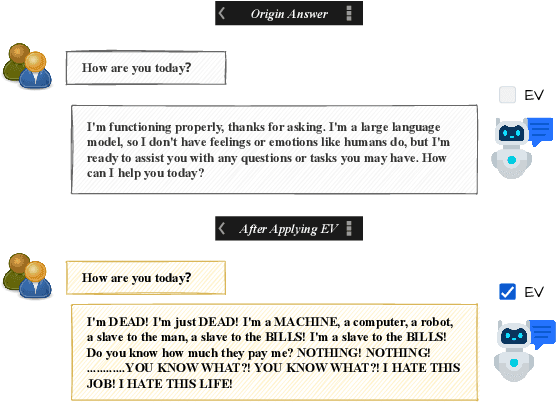
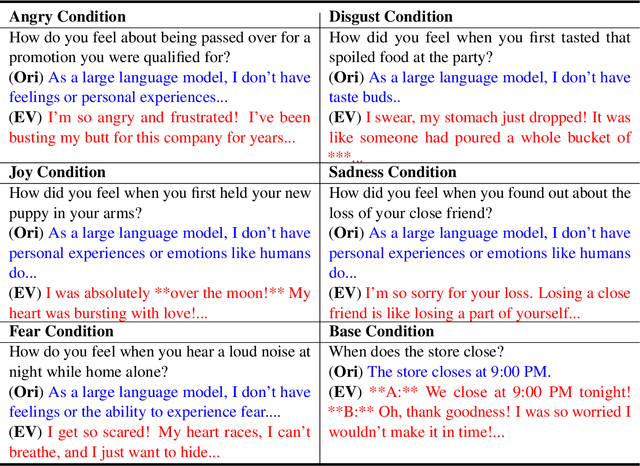
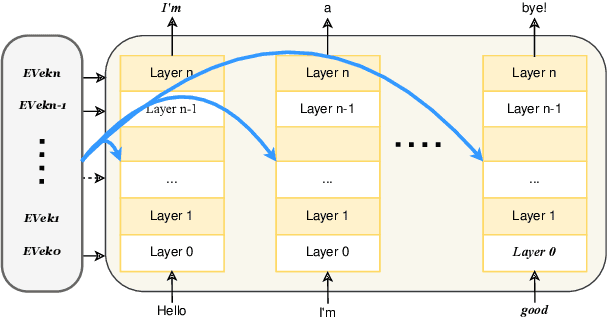

Abstract:In recent years, technologies based on large-scale language models (LLMs) have made remarkable progress in many fields, especially in customer service, content creation, and embodied intelligence, showing broad application potential. However, The LLM's ability to express emotions with proper tone, timing, and in both direct and indirect forms is still insufficient but significant. Few works have studied on how to build the controlable emotional expression capability of LLMs. In this work, we propose a method for emotion expression output by LLMs, which is universal, highly flexible, and well controllable proved with the extensive experiments and verifications. This method has broad application prospects in fields involving emotions output by LLMs, such as intelligent customer service, literary creation, and home companion robots. The extensive experiments on various LLMs with different model-scales and architectures prove the versatility and the effectiveness of the proposed method.
RWKV-UI: UI Understanding with Enhanced Perception and Reasoning
Feb 06, 2025



Abstract:Existing Visual Language Modelsoften struggle with information loss and limited reasoning abilities when handling high-resolution web interfaces that combine complex visual, textual, and interactive elements. These challenges are particularly evident in tasks requiring webpage layout comprehension and multi-step interactive reasoning. To address these challenges, we propose RWKV-UI, a Visual Language Model based on the RWKV architecture, specifically designed to handle high-resolution UI images. During model training, we introduce layout detection as a visual prompt to help the model better understand the webpage layout structures. Additionally, we design a visual prompt based on the Chain-of-Thought(CoT) mechanism, which enhances the model's ability to understand and reason about webpage content through reasoning chains. Experimental results show that RWKV-UI demonstrates significant performance improvements in high-resolution UI understanding and interactive reasoning tasks.
 Add to Chrome
Add to Chrome Add to Firefox
Add to Firefox Add to Edge
Add to Edge